|

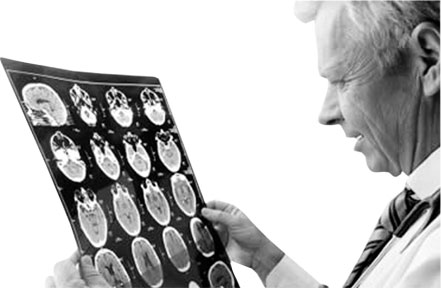 Second leading cause of death and paralysis in Sri
Lanka: Second leading cause of death and paralysis in Sri
Lanka:
Strokes
by Nilma DOLE
Neurologists in Sri Lanka have a vital role to play when it comes to
treating a patient’s nervous system and illnesses pertaining to it.
“There are several neurological disorders that are prevalent in society
today but the most common condition are strokes which is the second
leading cause of death and paralysis in Sri Lanka,” said President of
the College of Neurologists, Dr. Sunethra Senanayake. While there is a
National Stroke Association and Stroke Units to be implemented
island-wide, the trend of strokes affecting people continues.
“In simple terms, a stroke occurs when blood flow to a part of the
brain is stopped when a blood vessel in the brain is blocked or bursts
open. If the blood flow is stopped for longer than a few seconds, the
brain cannot get blood and oxygen causing brain cells can die, causing
permanent damage and even death,” said the doctor.
According to the doctor, there are two major types of stroke:
ischemic stroke and hemorrhagic stroke. Ischemic stroke occurs when a
blood vessel that supplies blood to the brain is blocked by a blood clot
forming in an artery that is already very narrow called a thrombus. A
clot at another blood vessel is called an embolism.
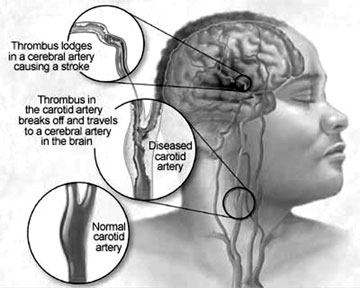 A hemorrhagic stroke occurs when a blood vessel in part of the brain
becomes weak and bursts open, causing blood to leak into the brain. Some
people have problems in the blood vessels of the brain that make this
more likely. The flow of blood that occurs after the blood vessel
ruptures damages brain cells. A hemorrhagic stroke occurs when a blood vessel in part of the brain
becomes weak and bursts open, causing blood to leak into the brain. Some
people have problems in the blood vessels of the brain that make this
more likely. The flow of blood that occurs after the blood vessel
ruptures damages brain cells.
“Several cases of stroke affect the breadwinner of the family and not
only does it hamper a person’s ability to work but a family member
should nurse the patient round-the-clock,” said the doctor.
She said that there is mental depression on part of the patient and
the family but strokes can be prevented if the trigger factors are
carefully assessed and controlled.
“An elderly person having diabetes, hypertension, high blood
pressure, obesity and a certain degree of stress are prone to have
strokes especially if they don’t check themselves regularly,” she said.
Moreover, a person with a family history of strokes and risk factors
connected to strokes is also susceptible to developing strokes.
“Elderly people usually have a high risk so they should go for
medical checkups frequently, controlling diseases such as diabetes,
obesity, high cholesterol, smoking and hypertension should be done. It
is a little price to pay for something deadly later,” she said. “As a
neurologist, we can promptly identify a stroke through a CT scan which
can assess the person’s condition,” she said.
From the time of diagnosis to treatment, a neurologist can identify
the gravity of the stroke and prescribe treatment and medication to curb
the stroke.
Dr. Senanayake said, “Disability affects 75% of stroke survivors
enough to decrease their employability but a considerable number of
stroke victims generally manage to recover partially and can manage to
do their work independently.”
However, it doesn’t mean that all stroke victims can’t be cured.
“Provided the right treatment is given and the correct physiotherapy is
done, strokes can be cured depending on how well the patient responds to
it,” she said.
While the most important illness in Sri Lanka for a neurologist are
strokes, there are young people who get strokes. “If young people get
it, such strokes can be easily cured with the right medication,” said
Dr. Senanayake.
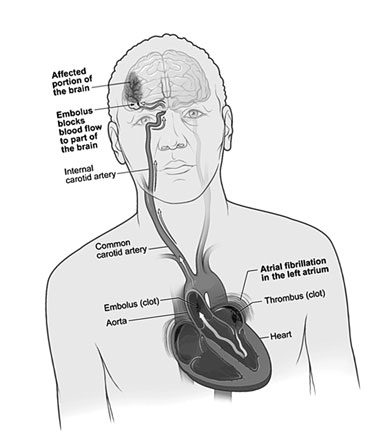 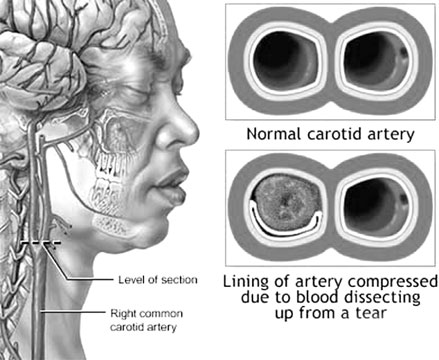 In addition, the neurologist’s role pertaining to nervous disorders
also encompasses epileptic disorders and headaches. In addition, the neurologist’s role pertaining to nervous disorders
also encompasses epileptic disorders and headaches.
There are many causes of epilepsy commonly seen in children and
adolescents. Birth traumas, meningitis, brain tumors and genetic
disorders can trigger epilepsy.
“When it comes to epilepsy, careful observations and studies should
be done on the patients and we work together with the paediatricians to
monitor and evaluate epileptic conditions especially in children,” said
the doctor. Moreover, the conditions pertaining to headaches revolve
around migranes, continuous headaches and headaches that occur on a
daily basis.
According to the doctor, common primary headaches are tension type
headaches. Headaches can be due to secondary causes such as tumors,
infections and hemorrhage in the brain.
“We carefully determine what sort of condition the patient has and
offer the right treatment and what they need to do in order to stop the
headaches with the right advice,” said Dr.Senanayake.
A neurologist is a physician who specialises in neurology, and is
trained to investigate, or diagnose and treat neurological disorders.
Neurologists may also be involved in clinical research, clinical
trials, as well as basic research and translational research. Overall,
the role of the Neurologists isn’t easy and it is important that we
realise that neurology is an important medical specialisation.
For more advice on how a neurologist can help you, attend the Sunday
Observer sponsored Medicare 2011 National Healthcare exhibition to
obtain a better understanding of aspects pertaining to health and
neurology.
MRI technique may predict, prevent strokes
Researchers at the University of Utah’s Comprehensive Arrhythmia and
Research Management (CARMA) Center have found that delayed-enhancement
magnetic resonance imaging (DE-MRI) holds promise for predicting the
risks of strokes, the third leading cause of death in the U.S. Their
latest study on a novel application of this technology appears in the
Feb. 15 issue of the Journal of the American College of Cardiology.
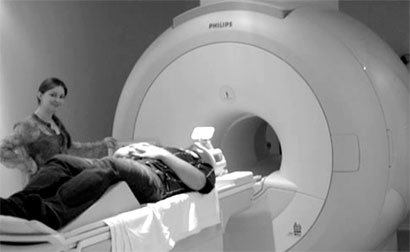 The study included 387 patients who were treated for atrial
fibrillation (AF) at either the University of Utah (Salt Lake City) or
Clinical Center Coburg (Coburg, Germany). AF is a little known heart
rhythm disorder that affects more than 3.5 million Americans and causes
more than 66,000 deaths a year. Individuals with AF are two to seven
times more likely to suffer a stroke than the general population. The study included 387 patients who were treated for atrial
fibrillation (AF) at either the University of Utah (Salt Lake City) or
Clinical Center Coburg (Coburg, Germany). AF is a little known heart
rhythm disorder that affects more than 3.5 million Americans and causes
more than 66,000 deaths a year. Individuals with AF are two to seven
times more likely to suffer a stroke than the general population.
The purpose of the study was to determine if there was an association
between an AF patient’s heart damage (for example, left atrial [LA]
fibrosis), which was detected using DE-MRI, and commonly used markers
for the risk of stroke, specifically the CHADS2 index. Although further
prospective studies are needed, the preliminary results indicate that
DE-MRI-based detection of LA fibrosis is independently associated with
prior history of strokes. The findings also provide preliminary evidence
that the physiological features of the LA could be used, in addition to
clinical features, when identifying stroke risk in patients.
“We believe this method can be a valuable tool for clinicians to use
in conjunction with the CHADS2 index for risk analysis and decisions
about anticoagulation medications when treating AF patients,” said
Nassir Marrouche, M.D., associate professor of cardiology and executive
director of the CARMA Center and Director, Cardiac Electrophysiology
Laboratories, for the University of Utah’s Division of Cardiology.
“Potentially, this will lead to improvement in current risk
stratification schemes and enhance our understanding of the risks of
thromboembolic (stroke) events in AF patients. We also hope this will
lead to the development of effective strategies for stroke prevention.”
Although the anticoagulant warfarin is highly effective in preventing
strokes, the drug also is associated with life-threatening hemorrhaging
and requires intensive dosage monitoring. Risk stratification schemes
have been developed to tailor anticoagulation therapy to the patients’
risk, and the CHADS2 index is the most accepted risk stratification
model. Yet while this index is a valuable tool for predicting
cerebrovascular events in high-risk patients, clinicians rely more
heavily on clinical judgment when predicting thromboembolic risk in
moderate-risk patients, a substantial portion of the AF population. The
identification of novel, independent risk factors by DE-MRI may
supplement existing tools to help guide clinician judgment in better
allocating anticoagulation therapeutic strategies, especially with
moderate risk AF patients.
The study concluded that LA fibrosis as determined through the use of
DE-MRI is “associated with an increased risk of thromboembolism in AF
patients. Clinician use of both a CHADS2 index and a quantified measure
of atrial fibrosis has the potential to provide a more rigorous risk
assessment and improve future risk stratification schemes.”
The University of Utah CARMA Center is conducting innovative research
on the use of MRIs to treat atrial fibrillation. In 2009, it opened the
first integrated electrophysiology (EP)-MRI research and clinical
laboratory in North America. This year, it has begun a worldwide patient
evaluation program at 16 international medical centers to investigate
the use of delayed enhancement MRI to stage the progression of the
disease. The CARMA Center also has developed the Utah AF Staging System,
which enables early detection and “personalized” treatment and
management for each atrial fibrillation patient.
Source: University of Utah Health Sciences
Guilty conscience can damage your immune system
by Cherry Norton
Feeling guilty about indulging in life’s pleasures can damage your
health - so if you want to stay in peak condition you should adopt a
more hedonistic approach, psychologists said in a recent report.
Research presented at the British Psychological Society’s annual
conference in Winchester showed that those who feel guilty about eating,
drinking, smoking or watching television suffered from a poorer immune
system, making them more vulnerable to colds and flu.
The findings also suggested that women felt more guilty about their
indulgences and were more likely to fall ill than men. Dr Geoff Lowe, a
chartered psychologist from the University of Hull, who conducted the
research said that people would be healthier if they relaxed and enjoyed
“sins” - as long as they are not harmful to them.
“We ought to focus more on the positive things in life. If we enjoy
simple pleasures that are not harmful to us we should not feel guilty
about them. We should maximise the pleasure,” he said. “We should take a
bit of time to smell the flowers.”
The findings showed that people who ate chocolate or watched daytime
television soap operas felt more guilt than pleasure after the event.
However having sex scored more than four times higher on pleasure than
guilt.
“If you anticipate having guilty feelings about something you are
less likely to do it. Guilty feelings are helpful in moderating harmful
behaviour but we also need a positive boost of regular pleasures in
order to reinforce the right kind of behaviour,” he said.
Dr Lowe and Dr John Greenman, an immunologist from Hull University,
asked 30 people to list their pleasurable activities and rate them for
guilt and pleasure.
Samples of their saliva were taken and tested for levels of
immunoglobulin A. High levels of this substance are associated with a
healthy immune system.
The participants rated their pleasures and the guilt associated with
them from one to 10.
Overall people enjoyed drinking and eating, giving them a score of
seven or eight on the pleasure scale, more than they felt guilty about
them, scoring five or six, but the guilt of eating chocolate, rating
eight, outweighed the pleasure, for which it scored seven. Men felt
significantly less guilty about drinking alcohol than women.
Going shopping was only slightly more pleasurable than
guilt-inducing, scoring eight out of 10 on the pleasure scale as against
seven for guilt.
- The Independent
Cholesterol levels and vitamins in large eggs
According to new nutrition data from the United States Department of
Agriculture’s Agricultural Research Service (USDA-ARS), eggs are lower
in cholesterol than previously thought. The USDA-ARS recently reviewed
the nutrient composition of standard large eggs, and results show the
average amount of cholesterol in one large egg is 185 mg, 14 percent
lower than previously recorded. The analysis also revealed that large
eggs now contain 41 IU of vitamin D, an increase of 64 percent.
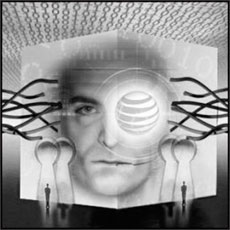 “We collected a random sample of regular large shell eggs from 12
locations across the country to analyze the nutrient content of eggs,”
says Dr. Jacob Exler, Nutritionist with the Agricultural Research
Service’s Nutrient Data Laboratory. “This testing procedure was last
completed with eggs in 2002, and while most nutrients remained similar
to those values, cholesterol decreased by 14 percent and vitamin D
increased by 64 percent from 2002 values.” “We collected a random sample of regular large shell eggs from 12
locations across the country to analyze the nutrient content of eggs,”
says Dr. Jacob Exler, Nutritionist with the Agricultural Research
Service’s Nutrient Data Laboratory. “This testing procedure was last
completed with eggs in 2002, and while most nutrients remained similar
to those values, cholesterol decreased by 14 percent and vitamin D
increased by 64 percent from 2002 values.”
The collected eggs were sent to a laboratory at Virginia Tech
University to be prepared for nutrient analysis at certified nutrient
analysis laboratories. The samples were randomly paired for the testing
procedure, and the analysis laboratories tested samples to determine
composition of a variety of nutrients including protein, fat, vitamins
and minerals. Accuracy and precision were monitored using quality
control samples.
According to Dr. Exler, this procedure is standard for the National
Food and Nutrient Analysis Program (NFNAP), the program responsible for
analyzing the nutrient composition of a wide variety of foods and making
nutrition information publicly available. This information is available
on the nutrient data lab website at www.ars.usda.gov/nutrientdata. The
new nutrient information will also be updated on nutrition labels to
reflect these changes wherever eggs are sold, from egg cartons in
supermarkets to school and restaurant menus.
Cracking egg myths
Over the years, people have unnecessarily shied away from eggs -
despite their taste, value, convenience and nutrition - for fear of
dietary cholesterol. However, more than 40 years of research have
demonstrated that healthy adults can enjoy eggs without significantly
impacting their risk of heart disease.
“My research focuses on ways to optimize diet quality, and I have
long suspected that eliminating eggs from the diet generally has the
opposite effect. In our own studies of egg intake, we have seen no
harmful effects, even in people with high blood cholesterol,” says Dr.
David Katz, Director of the Yale University Prevention Research Center.
Enjoying an egg a day can fall within current cholesterol guidelines,
particularly if individuals opt for low-cholesterol foods throughout the
day. The 2010 Dietary Guidelines for Americans suggest that eating one
whole egg per day does not result in increased blood cholesterol levels
and recommend that individuals consume, on average, less than 300 mg of
cholesterol per day. A single large egg contains 185 mg cholesterol.
Some researchers believe the natural decrease in the cholesterol level
of eggs could be related to the improvements farmers have made to the
hens’ feed. Hens are fed a high-quality, nutritionally balanced diet of
feed made up mostly of corn, soyabean meal, vitamins and minerals.
Poultry nutrition specialists analyze the feed to ensure that the
natural nutrients hens need to stay healthy are included in their diets.
Nutrition researchers at Iowa State University are compiling a report to
outline potential reasons for the natural decrease in cholesterol in
eggs.
Nutrient-rich eggs
Eggs now contain 41 IU of vitamin D, which is an increase of 64
percent from 2002. Eggs are one of the few foods that are a naturally
good source of vitamin D, meaning that one egg provides at least 10
percent of the Recommended Daily Allowance (RDA). Vitamin D plays an
important role in calcium absorption, helping to form and maintain
strong bones.
The amount of protein in one large egg - 6 grams of protein or 12
percent of the Recommended Daily Value - remains the same, and the
protein in eggs is one of the highest quality proteins found in any
food. Eggs are all-natural, and one egg has lots of vitamins and
minerals all for 70 calories.
Source: Egg Media Hotline
|

